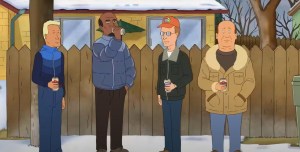Since Supergirl has mined so many great Superman stories and characters for ideas in the five seasons it has been on the air, it’s up to the writers and producers of The CW‘s planned Superman and Lois series, set to debut in the 2020-2021 TV season, to comb through the archives and come up with some stuff that hasn’t already been done in the various Superman movies and TV series, or on Supergirl, that can propel the story forward. Having kids (Jonathan Kent, as well as a new character named Jordan, will figure prominently in the series) will help a bit, but what might help more is looking back at a very particular part of Superman’s publishing history.
Videos by ComicBook.com
The post-Crisis on Infinite Earths, pre-Infinite Crisis Superman era has generally not been mined by Supergirl, and given that The CW just staged their own take on the classic comics crossover, it seems like an ideal time to revisit that era and see what it has to offer. Turns out, a lot, since more than maybe any other era of the Man of Steel’s history it plays like a TV, with big stories playing out over multiple interconnected issues while smaller subplots often centering on day-to-day struggles rather than end-of-the-world stuff.
We’ve run down a number of stories from the comics that can be done in the Arrowverse, and that don’t contradict existing lore (so — no Death of Superman because in “Crisis” we already established that Clark has faced Doomsday before). You can check them out below, and let us know what has you the most excited about Superman and Lois — and whether we missed any big stories from this era you would like to see updated for TV — in the comments.
Gang War

We have been beating the drum for years that Intergang should be a bigger part of Supergirl. The super-powered mafia just feels like an obvious source of weekly villains for any show that has a justification to use it. And in the ’80s, there was a “Gang War” storyline that set various factions of Metropolis’s organized crime community against one another.
One practical upshot of this story? It could give the TV series a chance to introduce Jose Delgado, the vigilante crimefighter known as Gangbuster.
Allie (and other tales of the Daily Planet)

With the Daily Planet reportedly suffering some financial difficulties in Superman and Lois (a leaked plot synopsis suggests that Clark Kent will be among a number of staffers laid off in the pilot), it could be a perfect opportunity to explore the personalities, struggles, and humanity of some of the Planet staffers who have rarely (if ever) gotten much attention on TV. Ron Troupe is a solid example of such a character, but maybe the most obvious direction to go would be with Allie, a receptionist who was always on the ball — in before everyone else and out after — until it was revealed that she had lost her second job and was secretly homeless, crashing at the Planet while she tried to get her life together.
In a real-world era of growing wealth inequality, it would not be difficult for a lot of fans to relate to someone who’s struggling to make ends meet while her employer lays off half her friends to turn a bigger profit. It also provided the gruff Perry White an opportunity to show his humanity by opening his home to a struggling employee — just a small part of a larger story that made Perry and Alice White some of the most beloved characters of the era.
On that note, let’s see Keith White. It is not yet clear whether Perry will actually be a part of the series, but it would be great to see Perry’s adoptive son Keith (and the long and winding journey he took to becoming adopted) play out in live action.
Dead Again

Following the events of “The Death of Superman,” four guys appeared seemingly out of nowhere to try and lay claim to the mantle of Metropolis’s greatest hero. While none of them turned out to be the real Superman, a later story — “Dead Again” — capitalized on some of the post-traumatic stress and confusion that story likely would have engendered in the people of Metropolis.
In “Dead Again,” Brainiac — who had at that point been off the board for quite a while — continued to play dead while using his powers to convince all of Metropolis that Superman’s body had been discovered and that the men walking around in his costume was an imposter. People turned against him, Superman even doubted himself, and it led him on an odyssey across the DC Universe, encountering old foes and trying to suss out just what was going on.
Kind of feels like a perfect big-picture plot for a second or third season, to be honest.
The Death of Clark Kent

Not to be confused with “The Death of Superman,” “The Death of Clark Kent” was a story that centered on a relatively new villain named Conduit. Originally Kenny Braverman, one of Clark Kent’s closest friends from childhood, Kenny grew up with something of an inferiority complex because Clark was always showing him up. Kenny’s father had exacerbated things by constantly comparing them.
And while the post-Crisis era gave us a version of Superman who got his powers in his late teens and never knowingly used them to belittle regular folks, Kenny became convinced that Clark had been cheating all those years, when he later realized that his old friend was the Man of Steel.
Conduit — who, by the way, got his powers after being irradiated with Kryptonite by Superman’s passing rocket, essentially making his origin the blueprint for so many characters on Smallville — would later target Superman’s loved ones, leading the hero to briefly believe that Lois and his parents had died and to “retire” the Clark Kent identity until after he could get a handle on the situation.
While the whole “killing” Clark Kent thing probably wouldn’t work (having two kids makes stories like that harder to do), the idea of Conduit learning his enemy’s identity and using his loved ones as leverage is certainly something that a guy with kids might be even more susceptible to.
The Trial of Superman

In a story that might give them an opportunity to explore some of Superman’s family history — as opposed to the tons of backstory already explored on Supergirl’s side of the family, who went to Argo City rather than dying with Krypton — Superman found himself arrested by an intergalactic court and tried for genocide.
Their logic? That a scientist many generations in Krypton’s past, who was related to Superman, had been responsible for the creation of The Eradicator, a device that made it impossible for most Kryptonians to escape the planet’s destruction. The tribunal responsible for trying the crimes had a strange religious dogma that allowed for the sins of the father to be visited upon the son, and this ultimately made the actions of Superman’s ancestors his problem.
If they do this one, is it too much to ask we get a flashback to Cameron Cuffe as Seg-El?
The Final Night

While The Final Night was a DC Universe-wide story (it centered on the sun going out and the heroes struggling to reignite it before all life on Earth froze over), Superman was at the center of it. The hero, whose powers come from solar radiation, found himself working through his body’s energy stores rapidly and ultimately lost his powers altogether. Meanwhile, the Legion of Super-Heroes and Lex Luthor, both big parts of the Superman mythology, played significant roles in stopping the crisis.
Superman and the Legion of Super-Heroes

The history of the post-Crisis on Infinite Earths Arrowverse is wide open. Was Clark Kent ever Superboy? Was it him or Kara who helped inspire and ultimately found the Legion of Super-Heroes? This could be a way to rebuild the Legion, which has been depleted and a little knocked around in Supergirl, while also giving a history of what Clark was like back when he was his sons’ age.
Electric Superman

If you were reading DC Comics in the late ’90s, it’s basically impossible you don’t remember that weird period when Superman’s powers inexplicably changed to being electicity-based and he had blue skin (later blue and red, when he was split into two different dudes).
That would be a ton of fun to explore on TV, and the idea of how it might play hell on his relationship with his wife and kids as his personalities got weird becuase of the red/blue swings could be cool. The “Electric Superman” story gets a bad reputation, but honestly there were some really cool ideas in there.
Superman: Lois & Clark

The very start of the Super-Sons/Rebirth era centered on a version of Superman who was more or less operating in secret. This is unlikely to be the case in the TV series, where he is a world-famous superhero already, but hear us out: the idea of the post-“Crisis” universe gives an opportunity to do one thing that Clark did in the Superman: Lois & Clark miniseries from writer Dan Jurgens and artist Lee Weeks.
The Superman in that story came from the pre-Flashpoint DC Universe and had lived through decades of continuity before his reality was rewritten by The New 52. He used that knowledge of the “future” to, in the relatively younger universe he found himself transported to, save lives by preventing certain tragedies (like supervillain origins that happened as a result of an accident) from happening at all.
That always seemed like a very SUPERMAN thing to do, and the post-Crisis rewriting of the timeline may give the hero an opportunity to do it at least once or twice. Think about how much better he could make the world if he prevented somebody like Hank Henshaw from ever becoming the Cyborg Superman.
Escape From Dinosaur Island

During Peter Tomasi and Patrick Gleason’s acclaimed run on Superman during the Rebirth era, one of the most popular stories saw Superman and his son Jonathan Kent (Superboy) transported to Dinosaur Island — now established as a real place in the Arrowverse — where they had to fend off dinosaurs while trying to help an old soldier stranded there for decades. Paying homage to Darwyn Cooke’s The New Frontier while setting up Jon’s career as Superboy, this feels like one of the most obvious stories to knock out as a one- or two-part episode.









